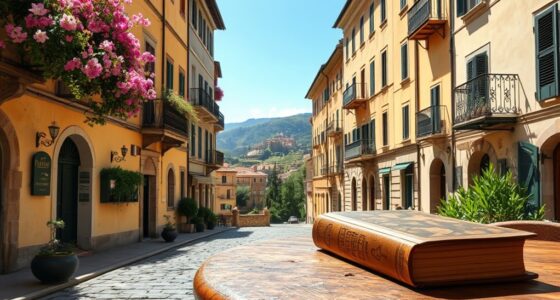Italy’s national parks are home to a diverse range of plants and animals that reflect the country’s rich natural heritage. You’ll find rare orchids, ancient olive groves, and lush forests, along with iconic wildlife like the Apennine chamois, Eurasian wolf, ibex, and golden eagle. These protected areas play a key role in conserving biodiversity amid threats like climate change and habitat loss. Keep exploring to discover how Italy’s parks safeguard these incredible species for future generations.
Key Takeaways
- Italy’s national parks protect diverse ecosystems hosting unique flora like rare orchids and ancient olive groves.
- Key fauna include Apennine chamois, Eurasian wolves, ibex, and golden eagles, some of which are reintroduced.
- Wetlands and forests support numerous migratory bird species, highlighting rich avian biodiversity.
- Conservation efforts focus on habitat restoration, invasive species control, and sustainable tourism.
- Parks serve as vital refuges ensuring the survival of Italy’s native plant and animal species for future generations.

Have you ever wondered where Italy’s breathtaking landscapes and rich biodiversity are protected? Italy’s national parks serve as essential refuges for countless plant and animal species, safeguarding biodiversity hotspots that are teeming with life. These parks are more than just scenic spots; they’re indispensable for conserving the country’s unique ecosystems amid rising conservation challenges. You’ll find that Italy’s diverse terrain—ranging from rugged mountains to lush forests—creates a mosaic of habitats, each hosting a distinct array of flora and fauna. These natural treasures face threats like urban expansion, agriculture, and climate change, which make effective conservation efforts indispensable. Conservation strategies are continually evolving to address these pressing issues and ensure the longevity of Italy’s natural heritage.
Within Italy’s national parks, you encounter a remarkable variety of species. For instance, the Apennine Mountains are home to the Apennine chamois and the Eurasian wolf, both of which have faced significant population declines. Similarly, the Alpine parks shelter species like the ibex and golden eagle, which have been reintroduced after periods of decline. The parks’ forests and wetlands support countless bird species, many of which are migratory and rely on these protected areas as critical stopovers. You’ll also find diverse plant life, from rare orchids to ancient groves of Mediterranean olive trees, each playing a crucial role in their ecosystems.
Discover Italy’s diverse species, from Apennine chamois and wolves to migratory birds and ancient olive groves.
However, conserving these species and habitats isn’t without its challenges. Italy’s biodiversity hotspots are increasingly threatened by human activities, and managing these pressures requires constant effort. Invasive species, illegal poaching, and habitat fragmentation continue to jeopardize native populations. Climate change exacerbates these issues by altering habitats, shifting migration patterns, and increasing the frequency of extreme weather events. You might notice that some parks are working tirelessly to restore habitats, control invasive species, and promote sustainable tourism, but balancing preservation with public access remains a complex task. Funding limitations and political priorities sometimes hinder conservation initiatives, making it harder to implement long-term strategies.
Despite these challenges, Italy’s national parks remain a symbol of the country’s commitment to preserving its natural heritage. They offer a sanctuary for flora and fauna, ensuring that future generations can experience Italy’s stunning landscapes and biodiversity. By supporting conservation efforts, you contribute to safeguarding these essential ecosystems from ongoing threats. The parks serve as living laboratories for scientific research, a source of inspiration for visitors, and a reminder of the importance of protecting our planet’s natural diversity. In the end, Italy’s national parks are more than just protected areas—they are the heart of the country’s ecological identity, indispensable for maintaining the delicate balance of life in this Mediterranean paradise.
Frequently Asked Questions
How Do Italy’S National Parks Contribute to Local Economies?
You’ll notice Italy’s national parks boost local economies by attracting eco tourism benefits, drawing visitors who spend on accommodations, food, and activities. This influx supports local business development, creating jobs and fostering entrepreneurship. As tourists explore these natural landscapes, they contribute directly to the community’s prosperity, ensuring sustainable growth. Your visit not only helps preserve Italy’s stunning environments but also provides essential economic support to nearby towns and businesses.
Are There Any Endangered Species Unique to Italy’S Parks?
Imagine walking through Italy’s lush parks, where endangered endemic species linger like hidden treasures. You’ll find rare native flora and animals unique to this land, such as the Apennine chamois and the Italian sparrow. These species face threats, making conservation vital. Protecting Italy’s parks safeguards these fragile creatures, ensuring their survival and enriching the natural tapestry that makes Italy’s wilderness truly exceptional.
What Conservation Programs Are Active Within Italy’S National Parks?
You should know that Italy’s national parks implement various conservation strategies focused on species protection. These programs include habitat restoration, strict anti-poaching laws, and breeding initiatives for endangered species. You can see these efforts in action through ranger patrols, environmental education, and research projects. By supporting and participating in these programs, you help guarantee the preservation of Italy’s unique flora and fauna for future generations.
How Accessible Are Italy’S Parks for Disabled Visitors?
Oh, don’t worry—Italy’s parks are practically a paradise for everyone, right? In reality, while some parks offer wheelchair accessibility and adaptive equipment, accessibility varies widely. You might find smooth paths and ramps in popular spots, but less-developed trails can be tricky. It’s best to check specific park facilities beforehand. With a little planning, you can enjoy Italy’s stunning nature, regardless of mobility challenges.
What Traditional Cultural Practices Are Preserved in Italy’S Parks?
In Italy’s parks, you’ll find traditional cultural practices like the preservation of folklore and traditional crafts. Visitors often witness local artisans demonstrating age-old techniques, such as pottery or weaving, which keep these skills alive. Festivals and storytelling sessions help you experience Italy’s rich folklore firsthand. By exploring these parks, you actively participate in safeguarding Italy’s cultural heritage, ensuring that these traditional practices continue to thrive for future generations.
Conclusion
Explore Italy’s national parks and discover a stunning variety of flora and fauna. Did you know that over 1,300 species of plants and more than 300 bird species call these parks home? As you wander through lush forests and rugged mountains, you’ll see firsthand the country’s rich natural diversity. Protecting these ecosystems guarantees future generations can enjoy Italy’s breathtaking landscapes and incredible wildlife—so get out there and experience the beauty for yourself!









